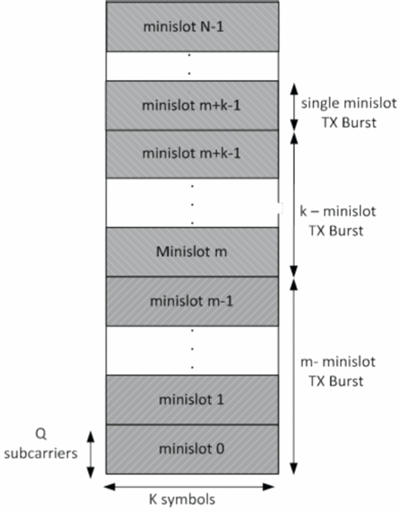OFDM and OFDMA
OFDM and OFDMA
The value added and what it means to my network
By now you have heard or have been exposed to orthogonal frequency division multiplexing (OFDM). It was the innovative technology introduced in Data-Over-Cable Service Interface Specifications (DOCSIS) 3.1 to increase the efficiency by which DOCSIS networks can transmit data in the downstream. Additionally, many cable operators are now actively deploying orthogonal frequency division multiple access (OFDMA), which was also introduced in the DOCSIS 3.1 specification in order to increase upstream bandwidth efficiency. So just what is the difference between OFDM and OFDMA?
OFDM uses multiplexing. Multiplexing is a method by which multiple digital signals are shared over a common medium, in this case the downstream HFC plant. The multiplexed signal is shared across all cable modems in the downstream, which is an especially important concept to keep in mind, particularly when we consider 1 gigabit per second (Gbps) and in the future, 10 Gbps bandwidths. The bandwidth is still shared amongst all subscribers. This means if we have an OFDM downstream capable of 1 Gbps or 10 Gbps, that does not mean each subscriber gets 1 Gbps or 10 Gbps, but all subscribers on the node are sharing 1 Gbps or 10 Gbps. Multiplexing = shared bandwidth.
OFDMA is used in DOCSIS 3.1 and DOCSIS 4.0 upstream communication. The “MA” at the end of OFDMA stands for multiple access. Multiple access is a method by which many users, or in the case of DOCSIS, many cable modems share the same upstream frequency spectrum. This same frequency spectrum is shared much the same way one would share a rental house at a beach. I get the house this week, you get the house next week and so on. The difference being that the CMTS will allocate time sharing on a microsecond time scale rather than a weekly time scale — size matters (note: frequency allocation and usage comes into play, too, but that’s a topic for another day). This is illustrated in Figure 1, from the CM-SP-PHYv3.1 specification, section 7.4.1.

OFDM vs OFDMA
At a high-level, OFDM is for downstream DOCSIS 3.1 communications and is a shared medium for all DOCSIS 3.1 and higher modems. OFDMA is for upstream communications for all DOCSIS 3.1 and higher modems but uses time slot and frequency allocation (like your beach rental) so that each modem is given a time slot or frequency range (group of subcarriers) to send its data. At this high-level, OFDM and OFDMA signals can otherwise be considered similar.
At the technical level, there are many other differences between OFDM and OFDMA signals. While not comprehensive, here is a short-bulleted breakdown of some key differences:
- OFDM includes low density parity check (LDPC) and an extra layer of error correction called BCH (Bose–Chaudhuri–Hocquenghem), while OFDMA supports only LDPC
- OFDM supports bandwidth from 24 MHz to 192 MHz while OFDMA supports bandwidths from 6.4 MHz to 96 MHz
- OFDM requires modulations up to 4096-QAM with optional support to 16384-QAM while OFDMA requires modulations up to 1024-QAM with optional support up to 4096-QAM
Figure 1. OFDMA frame structure showing how minislot timing is allocated to subcarriers
Other considerations
When cable operators begin utilizing DOCSIS 3.1 OFDMA in the upstream they will require advanced software tools to have clear visibility into the OFDMA channel. OFDMA requires CMTS/CCAP integration in order to have full visibility into the OFDMA upstream. To do so, CableLabs has created a special set of management information base (MIB) called the upstream triggered spectrum capture (UTSC) MIB which allows for precision control and visibility of OFDMA carriers. This provides for unprecedented upstream spectrum analysis and the ability to see ingress, impulse noise and more within the OFDMA channel in the upstream. This cannot be done with a traditional external monitoring system without proactive network maintenance (PNM). An operator can use a stand-alone PNM product or one that has been integrated with PNM. Either way you need PNM to see the OFDMA upstream.
The situation only becomes more aggravated with DOCSIS 4.0 where full duplex DOCSIS and/or extended spectrum will be implemented. As operators turn up DOCSIS 3.1 in the upstream they will quickly realize their hardware-based return path monitoring systems are not what they used to be. Of course, not every operator has turned on DOCSIS 3.1 OFDMA but OFDMA channel usage is becoming more common. Technology evolution is normal and with the improvements of OFDMA it is in with the new and out with the old.
Here are some related links to DOCSIS 3.1 written by me in Broadband Library:
CCAP and Cable Modems the New Rock Stars in DOCSIS 3.1 Test
https://broadbandlibrary.com/docsis-3-1-test/
Demystifying OOB and R-PHY
https://broadbandlibrary.com/out-of-band/
Show Me the Money!
https://broadbandlibrary.com/remote-phy/
Summary
OFDM and OFDMA are both advantageous to use over the traditional single carrier QAM (SC-QAM) which have been the staple of all previous versions of DOCSIS until DOCSIS 3.1. This is because SC-QAM worked for our needs. However, OFDM and OFDMA are able to transmit data more efficiently and more robustly than SC-QAM carriers.
OFDM and OFDMA look quite similar from an initialism [1] standpoint, but in fact are used very differently in DOCSIS 3.1 and 4.0. OFDM is used in the downstream and is a common channel shared by all compatible cable modems. OFDMA is used in the upstream by cable modems transmitting data to the CMTS. OFDMA is a time- and frequency-shared medium, meaning the CMTS schedules time and frequency slots to the modems allowing the modems to time share the same frequency and transmit their data on OFDMA subcarriers on the upstream. As mentioned, there are many other differences between OFDM and OFDMA, but understanding the primary high-level differences will help you as you move your way up the DOCSIS ladder.
References:
[1] The word initialism was drilled into me by my longtime friend – Mr. Ron Hranac. For those, who like me, are confused by the word “initialism” here is the definition: “An initialism is a term formed by abbreviating a phrase by combining certain letters of words in the phrase (often the first initial of each) into a single term. Common examples of initialisms include FBI (an initialism of Federal Bureau of Investigation) and TMI (an initialism of too much information).” Source: dictionary.com
Data-Over-Cable Service Interface Specifications DOCSIS® 3.1 CM-SP-PHYv3.1-I16-190121
 Brady S. Volpe
Brady S. Volpe
brady.volpe@volpefirm.com
Brady Volpe is Founder of The Volpe Firm, Inc and Nimble This LLC. He has over 25 years of broadband cable and telecommunications industry experience specializing in RF, DOCSIS, PNM, and Internet Protocol. Mr. Volpe has been providing a wide range of troubleshooting, design solutions, services and seminars for cable operators and broadband companies specializing in DOCSIS, System Design, PNM, and Troubleshooting. He is a highly respected published speaker, both domestically and internationally. He also hosts a popular industry YouTube and Podcast – “Get Your Tech On“. Mr. Volpe has a MSEE with honors and a BSEE.
Shutterstock





Pingback: OFDM and OFDMA - Volpe Firm